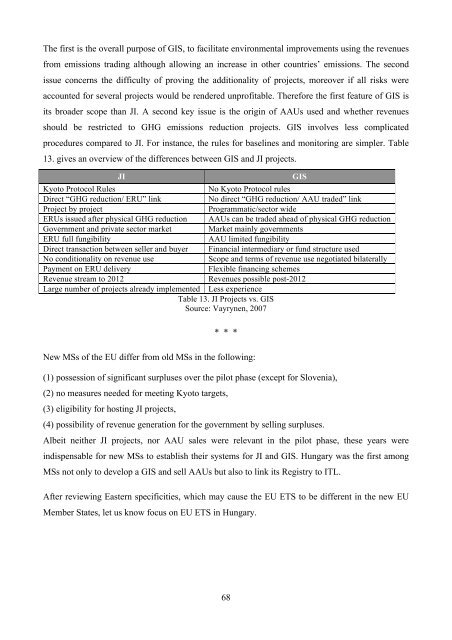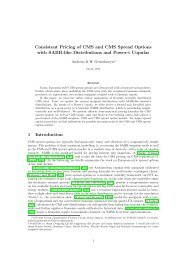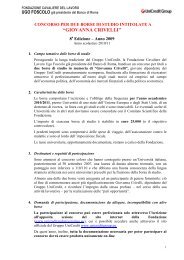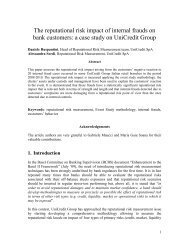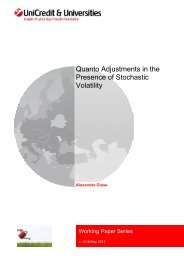Dóra Fazekas Carbon Market Implications for new EU - UniCredit ...
Dóra Fazekas Carbon Market Implications for new EU - UniCredit ...
Dóra Fazekas Carbon Market Implications for new EU - UniCredit ...
You also want an ePaper? Increase the reach of your titles
YUMPU automatically turns print PDFs into web optimized ePapers that Google loves.
The first is the overall purpose of GIS, to facilitate environmental improvements using the revenues<br />
from emissions trading although allowing an increase in other countries’ emissions. The second<br />
issue concerns the difficulty of proving the additionality of projects, moreover if all risks were<br />
accounted <strong>for</strong> several projects would be rendered unprofitable. There<strong>for</strong>e the first feature of GIS is<br />
its broader scope than JI. A second key issue is the origin of AAUs used and whether revenues<br />
should be restricted to GHG emissions reduction projects. GIS involves less complicated<br />
procedures compared to JI. For instance, the rules <strong>for</strong> baselines and monitoring are simpler. Table<br />
13. gives an overview of the differences between GIS and JI projects.<br />
JI GIS<br />
Kyoto Protocol Rules No Kyoto Protocol rules<br />
Direct “GHG reduction/ ERU” link No direct “GHG reduction/ AAU traded” link<br />
Project by project Programmatic/sector wide<br />
ERUs issued after physical GHG reduction AAUs can be traded ahead of physical GHG reduction<br />
Government and private sector market <strong>Market</strong> mainly governments<br />
ERU full fungibility AAU limited fungibility<br />
Direct transaction between seller and buyer Financial intermediary or fund structure used<br />
No conditionality on revenue use Scope and terms of revenue use negotiated bilaterally<br />
Payment on ERU delivery Flexible financing schemes<br />
Revenue stream to 2012 Revenues possible post-2012<br />
Large number of projects already implemented Less experience<br />
Table 13. JI Projects vs. GIS<br />
Source: Vayrynen, 2007<br />
* * *<br />
New MSs of the <strong>EU</strong> differ from old MSs in the following:<br />
(1) possession of significant surpluses over the pilot phase (except <strong>for</strong> Slovenia),<br />
(2) no measures needed <strong>for</strong> meeting Kyoto targets,<br />
(3) eligibility <strong>for</strong> hosting JI projects,<br />
(4) possibility of revenue generation <strong>for</strong> the government by selling surpluses.<br />
Albeit neither JI projects, nor AAU sales were relevant in the pilot phase, these years were<br />
indispensable <strong>for</strong> <strong>new</strong> MSs to establish their systems <strong>for</strong> JI and GIS. Hungary was the first among<br />
MSs not only to develop a GIS and sell AAUs but also to link its Registry to ITL.<br />
After reviewing Eastern specificities, which may cause the <strong>EU</strong> ETS to be different in the <strong>new</strong> <strong>EU</strong><br />
Member States, let us know focus on <strong>EU</strong> ETS in Hungary.<br />
68


